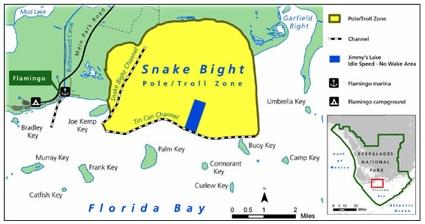Some boating rules are changing Jan. 1 at Everglades National Park, where Snake Bight in Florida Bay will be designated a "pole and troll boating zone," according to park officials.
“This new protective zone was created to provide enhanced protection of Snake Bight’s sensitive aquatic vegetation and wilderness resources, improve the quality of flats fishing, enhance paddling and wildlife viewing opportunities, and expand education on proper shallow water boating techniques,” said Everglades Superintendent Dan Kimball.
According to a park release, "boaters should be aware that within the pole and troll zone, internal combustion motors can only be used in Tin Can or Snake Bight channels (where on-plane transit is permitted), and in the Jimmy’s Lake idle speed-no wake area. Within all other areas of the pole and troll zone, boats may only be propelled by push poles, paddles, or electric trolling motors."
The new management approach evolved from 2009 meetings over the park's General Management Plan. Those public meetings offered discussion and input over scientific research in the park's waters as well as visitor trends.
"That effort resulted in meaningful public input on ways to improve management of Florida Bay," park officials said in a news release. "Park staff developed several alternatives for a pole and troll zone, held public meetings, and received written comments over the past year on how to best implement a pole and troll zone in Florida Bay. In response to public input and support, park management selected the Snake Bight area to implement a pole and troll zone in advance of adopting the GMP, expected to be completed in 2012."
Park staff has prepared some waterproof brochures, in both English and Spanish, to be distributed at the park entrance station and at local bait and tackle shops, marinas, and boat ramps. Rangers will also be talking with recreational anglers and park fishing guides about the new zone to ensure park users understand the new regulations.
“This protective management measure should help prevent new seagrass scars in that area of the bay that take several years to recover and negatively impact the ecology of the bay,” said Superintendent Kimball.
The park received financial support for the project from the US Fish and Wildlife Service’s Coastal Restoration grant program and donations from the Herman Lucerne Foundation, the Flamingo Friendly Tournament, and the South Florida National Parks Trust. These funding sources allowed the park to print educational materials, fabricate and install signs, and conduct scientific monitoring activities.
As part of this new program, the park is implementing a monitoring plan to help assess the pole and troll zone’s effectiveness in protecting seagrass, while enhancing fishing and other recreational experiences, the park said.




Add comment